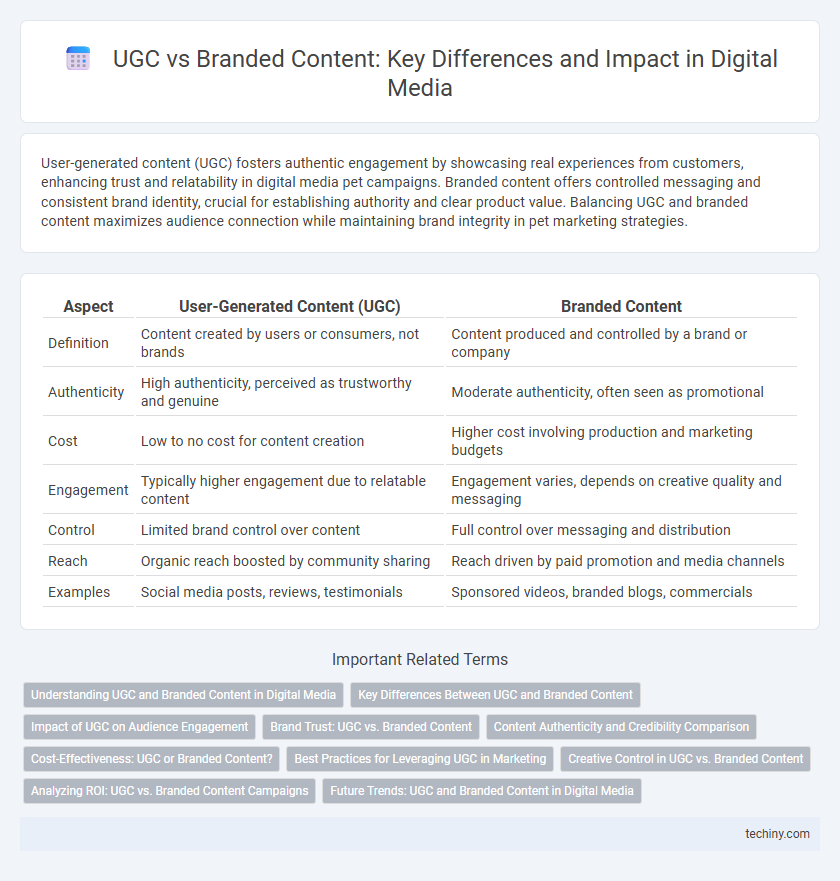User-generated content (UGC) fosters authentic engagement by showcasing real experiences from customers, enhancing trust and relatability in digital media pet campaigns. Branded content offers controlled messaging and consistent brand identity, crucial for establishing authority and clear product value. Balancing UGC and branded content maximizes audience connection while maintaining brand integrity in pet marketing strategies.
Table of Comparison
| Aspect | User-Generated Content (UGC) | Branded Content |
|---|---|---|
| Definition | Content created by users or consumers, not brands | Content produced and controlled by a brand or company |
| Authenticity | High authenticity, perceived as trustworthy and genuine | Moderate authenticity, often seen as promotional |
| Cost | Low to no cost for content creation | Higher cost involving production and marketing budgets |
| Engagement | Typically higher engagement due to relatable content | Engagement varies, depends on creative quality and messaging |
| Control | Limited brand control over content | Full control over messaging and distribution |
| Reach | Organic reach boosted by community sharing | Reach driven by paid promotion and media channels |
| Examples | Social media posts, reviews, testimonials | Sponsored videos, branded blogs, commercials |
Understanding UGC and Branded Content in Digital Media
User-Generated Content (UGC) refers to authentic material created by consumers or users, often shared on social media platforms, which enhances brand credibility and community engagement. Branded Content, produced directly by companies or agencies, strategically promotes products or services through storytelling to build brand identity and influence target audiences. Understanding the differences in creation, intent, and impact of UGC versus Branded Content is essential for optimizing digital media marketing strategies.
Key Differences Between UGC and Branded Content
User-Generated Content (UGC) is created by consumers and reflects authentic experiences, while Branded Content is professionally produced by companies to promote a specific brand or product. UGC drives higher engagement and trust due to its organic nature, whereas Branded Content offers greater control over messaging and visual appeal. The key differences lie in content origin, authenticity, control, and impact on audience perception within digital media strategies.
Impact of UGC on Audience Engagement
User-Generated Content (UGC) drives higher audience engagement by fostering authenticity and trust, often generating 28% more interaction compared to branded content. This organic participation encourages community building and increases brand loyalty through relatable, real-life experiences shared by users. UGC's impact is evident in conversion rates, which can rise up to 20% when customers perceive content as genuine rather than promotional.
Brand Trust: UGC vs. Branded Content
User-Generated Content (UGC) significantly enhances brand trust by showcasing authentic customer experiences and peer reviews, which audiences perceive as more credible than traditional advertisements. Branded content, while professionally produced and aligned with brand messaging, often lacks the genuine voice and relatability found in UGC, making it less effective in building emotional connections. Studies reveal that 79% of consumers say UGC highly impacts their purchasing decisions, highlighting its critical role in establishing trust and loyalty.
Content Authenticity and Credibility Comparison
User-Generated Content (UGC) often outperforms branded content in perceived authenticity due to its genuine, unfiltered nature, reflecting real consumer experiences and emotions. Branded content, while professionally crafted, can sometimes be viewed as biased or promotional, which may affect its credibility among skeptical audiences. Research indicates that audiences trust UGC 2.4 times more than traditional branded advertisements, making authenticity a critical factor in digital media strategies.
Cost-Effectiveness: UGC or Branded Content?
User-Generated Content (UGC) typically offers higher cost-effectiveness compared to branded content due to lower production expenses and organic audience engagement. Branded content requires significant investment in creative development, professional production, and targeted distribution to maintain brand consistency and quality. Brands leveraging UGC benefit from authentic customer voices that increase trust and conversion rates while minimizing marketing budgets.
Best Practices for Leveraging UGC in Marketing
User-generated content (UGC) enhances brand authenticity by showcasing genuine consumer experiences, making it an essential strategy in digital media marketing. Brands should encourage content creation through contests and hashtags, ensuring clear guidelines to maintain quality and relevance while fostering engagement. Leveraging UGC alongside branded content optimizes reach and trust, driving higher conversion rates through relatable storytelling and community involvement.
Creative Control in UGC vs. Branded Content
Creative control in User-Generated Content (UGC) is decentralized, allowing consumers to produce authentic and diverse content that resonates with peer audiences, whereas branded content maintains centralized creative oversight to align messaging tightly with brand identity and strategic goals. UGC fosters organic engagement through user authenticity, often resulting in a variety of narrative styles and visual approaches, while branded content emphasizes polished production values and consistent thematic elements to reinforce brand positioning. This distinction in creative control impacts content scalability, audience trust, and the balance between grassroots appeal and professional brand storytelling in digital media strategies.
Analyzing ROI: UGC vs. Branded Content Campaigns
User-generated content (UGC) campaigns often deliver higher ROI due to enhanced authenticity, trust, and engagement rates compared to branded content, which can be perceived as less genuine. Data shows UGC drives 28% higher engagement and reduces content production costs by 40%, resulting in more efficient budget allocation. Brands leveraging UGC benefit from organic reach and increased conversion rates, making it a cost-effective strategy for digital media marketing ROI optimization.
Future Trends: UGC and Branded Content in Digital Media
Future trends in digital media indicate an increasing blend of User-Generated Content (UGC) and branded content, leveraging authentic consumer voices to enhance brand trust and engagement. Platforms like TikTok and Instagram are evolving algorithms to prioritize UGC, driving higher interaction rates and community-driven marketing strategies. Brands are investing in hybrid content models that balance creative control with genuine user participation to maximize reach and conversion in evolving digital ecosystems.
UGC (User-Generated Content) vs Branded Content Infographic

 techiny.com
techiny.com